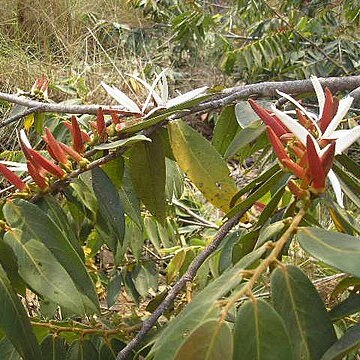Trees [or shrubs]. Flowers axillary, solitary [or fasciculate]. Flower buds lanceolate [to subulate]. Pedicel usually short, bracteolate at apex [or base]. Sepals 3, valvate, thick, connate at base sometimes into a cup-shaped calyx. Petals 6, in 2 whorls, with each whorl valvate, connivent or scarcely open, elongated, thick, woody when dry, inside basally concave, middle narrowly convex; outer petals larger and longer than inner petals. Stamens many; anther locules oblong, extrorse, transversely septate; connectives 3-angular, apex truncate-dilated. Carpels few to many, free; ovules 2-6 per carpel, sutural; styles elongated; stigmas clavate [capitate, or oblong], extended. Fruit apocarpous; monocarps stipitate, oblong [to elongated], moniliform, often dehiscent. Seeds [1-]3-8[to many] per monocarp, ovoid; aril present but often inconspicuous.
Trees or shrubs, unarmed, with simple hairs. Flowers bisexual, axillary, solitary or in pairs or (not in Australia) in multiflowered cymes or fascicles. Sepals valvate in bud, shortly or largely connate at base. Petals 6, both series valvate in bud, concave inside above base; inner series shorter and narrower than outer. Stamens mostly linear-oblong with connective above dilated; anther cells transversely septate. Pollen grains united in tetrads. A few staminodes present adjacent to the carpels. Carpels few to many, ovules 1-many; style and stigma linear to clavate. Apocarps follicular, dehiscent on one side, or (not in Australia) indehiscent, stipitate. Seeds 1-several, arillate.
Shrubs or trees. Flowers usually small, sessile or shortly pedicellate, in axillary inflorescences or sometimes produced from old branches or from the trunk. Sepals small, valvate in bud, nearly free or connate into a cupular calyx. Petals thick, valvate, linear-oblong or sometimes deltoid. Stamens numerous, the anther cells locellate; connective expanded above the anther. Ovaries hidden in a deep cavity in the center of the torus; ovules lateral. Monocarps free, cylindric or sometimes short, clavate, containing a row of rather few seeds.
Petals 6, free, in two subequal or unequal whorls, both valvate, thick, erect or spreading, flat or triquetrous and often linear above, broad and ± concave at the base, the inner ones sometimes with a fleshy pad covering the reproductive parts.
Stamens ?, linear, with thecae extrorse, septate and connective-prolongation, capitate, the outer and inner ones often flattened and staminodial; filaments articulated, the bases sometimes united, enclosing the gynoecium.
Carpels ? to few (rarely solitary), free, ovoid-cylindric or ± flattened, with several 1-seriate or biseriate ovules; styles cylindric or narrowly clavate, aggregated.
Flowers bisexual, solitary or in cymes or fascicles, axillary, pedicellate or sessile, often (? always) fragrant.
Seeds vertical to horizontal, collateral or biseriate; aril present (sometimes inconspicuous).
Trees, shrubs or shrublets, not climbing, with simple or rarely forked hairs.
Ripe carpels dehiscent, ± succulent, cylindric or obovoid, 1–8-seeded.
Sepals 3, valvate, much shorter than the petals, ± united.
Bracteoles (1) 2–5, caducous or persistent.
Buds triquetrous or conic.

